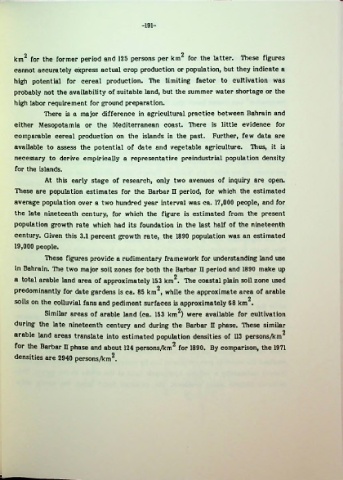Page 215 - Life & Land Use on the Bahrain Islands (Curtis E Larsen)
P. 215
-191-
km2 for the former period and 125 persons per km2 for the latter. These figures
cannot accurately express actual crop production or population, but they indicate a
high potential for cereal production. The limiting factor to cultivation was
probably not the availability of suitable land, but the summer water shortage or the
high labor requirement for ground preparation.
There is a major difference in agricultural practice between Bahrain and
either Mesopotamia or the Mediterranean coast. There is little evidence for
comparable cereal production on the islands in the past. Further, few data are
available to assess the potential of date and vegetable agriculture. Thus, it is
necessary to derive empirically a representative preindustrial population density
for the islands.
At this early stage of research, only two avenues of inquiry are open.
'Hiese are population estimates for the Barbar n period, for which the estimated
average population over a two hundred year interval was ca. 17,000 people, and for
the late nineteenth century, for which the figure is estimated from the present
population growth rate which had its foundation in the last half of the nineteenth
century. Given this 3.1 percent growth rate, the 1890 population was an estimated
19,000 people.
TTiese figures provide a rudimentary framework for understanding land use
in Bahrain. The two major soil zones for both the Barbar n period and 1890 make up
o
a total arable land area of approximately 153 km . The coastal plain soil zone used
o
predominantly for date gardens is ca. 85 km , while the approximate area of arable
2
soils on the colluvial fans and pediment surfaces is approximately 68 km .
Similar areas of arable land (ca. 153 km ) were available for cultivation
during the late nineteenth century and during the Barbar n phase. These similar
2
arable land areas translate into estimated population densities of 113 persons/km
for the Barbar n phase and about 124 persons/km2 for 1890. By comparison, the 1971
densities are 2940 persons/km2.

